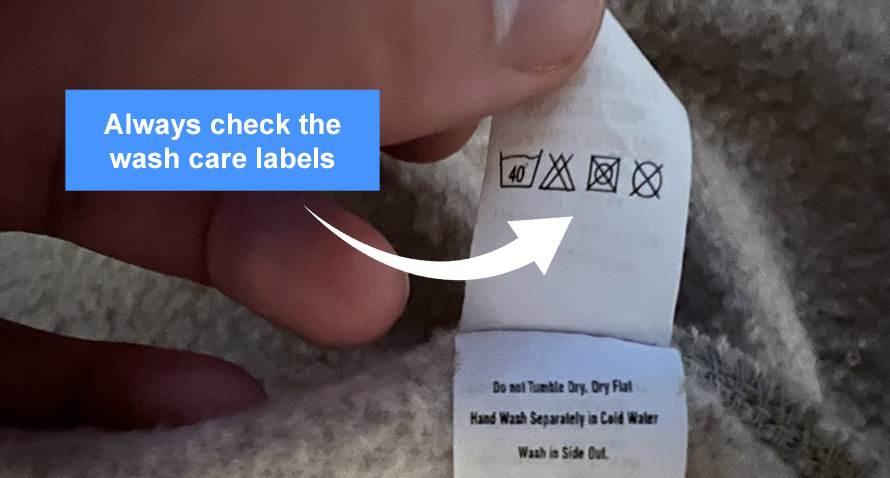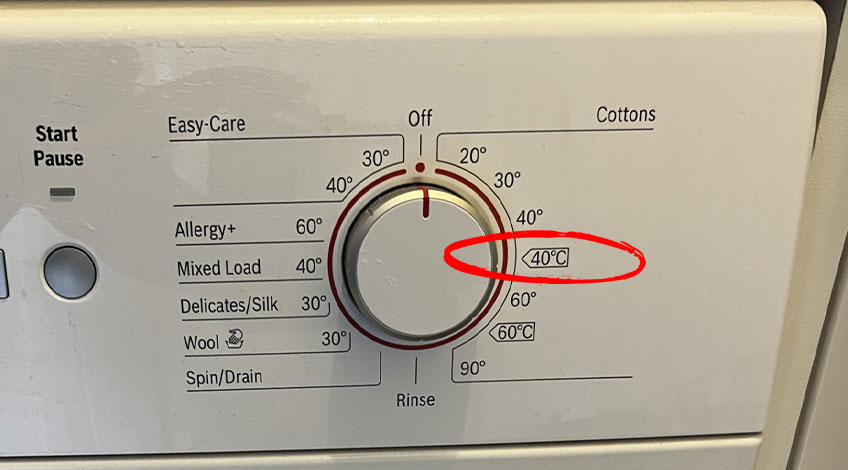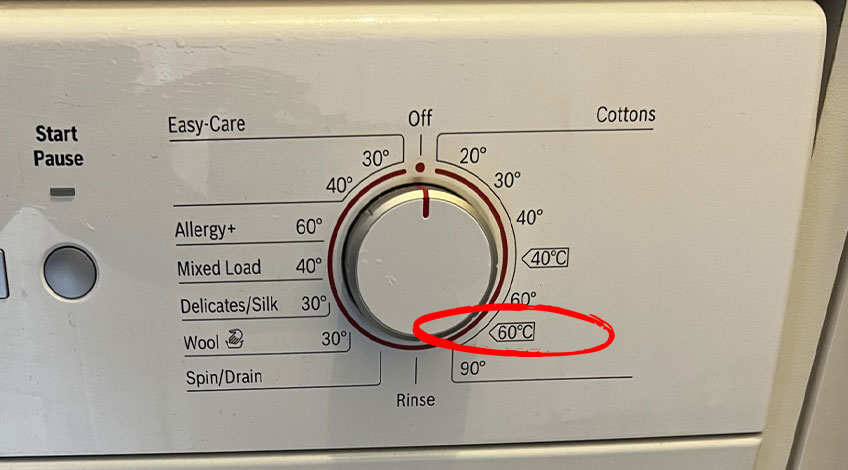
What Temperature Is Best To Wash Clothes At? (& when to use each)
There are so many options now when it comes to using the washing machine. With so many programmes, cycles and temperatures available it can be very difficult to know which one to use.
If you’re uncertain as to which temperature you should be washing your clothes at, keep reading. In this article we look at which temperature is best to wash your clothes at, which items to wash at that temperature and when you should use each one.
| Fabric | Recommended Wash Temperature |
|---|---|
| Shirts | 30 degrees |
| Summer Clothes | 30 degrees or 40 degrees if heavily soiled |
| Shorts | 30 degrees or 40 degrees if heavily soiled |
| T-Shirts | 30 degrees or 40 degrees if heavily soiled |
| Jeans (Denim) | 30 degrees or 40 degrees if heavily soiled |
| Coloured Clothes | 30 degrees or 40 degrees if heavily soiled |
| Delicate fabrics | 30 degrees or below |
| Synthetics | 40 degrees or below |
| Cotton | 30 degrees or 40 degrees if heavily soiled |
| Coloured Towels | 40 degrees |
| Bedding | 40 degrees |
| Underwear | 60 degrees |
| Cotton | 40 degrees |
| Wool | 40 degrees |
| Heavily Soiled Items | 40 degrees or 60 degrees depending on type of stain/if fabric can withstand it |
| White Towels | 60 degrees or 90 degrees if heavily soiled |
| Bed Sheets | 60 degrees or 90 degrees if heavily soiled |
| Terry Nappies | 60 degrees or 90 degrees if heavily soiled |
| Kitchen Towels/Tea Towels | 60 degrees or 90 degrees if heavily soiled |
| Mattress Protectors | 60 degrees or 90 degrees if heavily soiled |
| Black Clothes | 20 degrees or no warmer than 30 degrees |
| Baby Clothes | 30 – 40 degrees |
| Socks | 30 degrees or no higher than 40 degrees |
PLEASE NOTE: This table is a general guide, please read to learn more about the specific temperatures you should use in specific circumstances. For example, some stains, particularly blood and milk based stains should only be washed at low temperatures. This is because high temperatures can actually bake the stain into the fabric.
Always Check What The Care Label Tells You

Before we get into the recommended temperature settings, always be sure to check what the care label on the garment tells you. This is important because it does vary from garment to garment and there’s not always a consistent temperature to be used for one specific type of fabric.
The wash care label will show you symbols that explain how you need to wash the item.
Look out for the symbol of a bucket with water in and a number. This is the temperature they recommended you wash the item at.
For example, if this symbol shows the bucket of water with the number 40 above it, that means they suggest washing at 40 degrees. If it says 60, they mean 60 degrees and so on.
The 20 Degree Wash Cycle
In 2013 legislation was passed that meant all new washing machines had to include a 20 degree C wash cycle. This was part of the government’s whole green agenda and was intended to save energy.
An added bonus is the reduced costs associated with lower electricity usage.
This programme is really only any good for washing lightly soiled or slightly dusty clothes that just need freshening up. Or delicate items like silk.
This cycle should only be used for a few bits and pieces and is not really suitable for washing a full load. It’s certainly not good enough to remove ingrained stains or bacteria and should only be used to spruce up slightly dusty clothes.
Only using the 20 degree programme would lead to a build up of detergent, mould, mildew and bacteria inside the drum, detergent dispenser, door seal and pipes of your washing machine. This can lead to your machine smelling musty and damp.
We recommend running a hot (90 degrees) service wash once a month to prevent this from becoming a problem.
20 Degree Wash Benefits
The benefits of using the 20 degree wash cycle include;
- Saves Energy
- Saves Money
- Great For Washing Delicates
- Environmentally Friendly
Disadvantages Of 20 Degree Wash
The disadvantages of using a 20 degree cycle include;
- Doesn’t Remove Bacteria
- Doesn’t Clean Soiled Clothes
- Increases The Risk Of Mould & Mildew Build Up
- More Frequent Service Washes
The 30 Degree Wash Cycle
This is the most commonly used wash cycle on modern washing machines. As long as you use a detergent designed for low temperature wash cycles, your clothes will be just as clean at 30 degrees as they would be using a higher temperature.
It’s an energy saving cycle and is great for washing clothes made from silk, wool or any fabric likely to shrink if exposed to high temperatures. It’s also a great choice for clothes likely to fade or have their colours run as it’s too much heat that encourages colours to run.
It costs slightly more to operate the machine at 30 degrees compared to the 20 degree wash cycle, but it uses less energy than any of the hotter wash cycles.
However, there are many stubborn stains that can’t be removed using just a 30 degree wash, even with a specially formulated detergent. Many stains will need to be pre-soaked or pretreated before washing to ensure the successful removal of ingrained stains.
Also, 30 degrees is not hot enough to kill all germs and bacteria. To be sure that your laundry is bacteria free, you’ll need to use either a hot wash, or a laundry sanitiser with the laundry working alongside the low temperature detergent.
30 Degree Wash Benefits
The main benefits of washing clothes at 30 degrees include;
- Suitable For Washing Delicate Items
- Helps To Prevent Shrinkage
- Helps To Prevent Colours Running
- Suitable For Washing Many Fabrics
Disadvantages Of 30 Degree Wash
The main disadvantages of using a 30 degree wash cycle include;
- Doesn’t Remove Ingrained Stains
- Doesn’t Kill All Germs & Bacteria
- Costs More to Run Compared To 20 Degree Cycle
- You’ll Need A Specially Formulated Detergent
The 40 Degree Wash Cycle

If you’ve been doing the laundry for a number of years, the 40 degree setting is probably your “go to” setting. It is considered to be a warm wash and is known to give better results than a cool wash cycle.
Especially when washing cotton, synthetics, denim, blended items and wool. It is also the wash cycle that many consumer watchdogs use to compare washing machine performance.
The 40 degree wash cycle gives you the best of both worlds. It’s hot enough to remove many germs and bacteria but cool enough to be gentle on many fabrics that could shrink.
40 Degree Wash Benefits
The main benefits to using a 40 degree wash cycle include;
- Good For Washing Coloured Towels
- Good For Washing Many Fabrics
- Saves Energy Compared To Higher Wash Cycles
- Most Popular Wash Cycle
Disadvantages Of 40 Degree Wash
There are a few disadvantages to using the 40 degree wash cycle which include;
- Not Suitable For Some Delicate Fabrics
- Uses More Electricity Than Cooler Cycles
- Can Be Quite A Long Cycle
The 50 Degree Wash Cycle (less common nowadays)
This cycle tends to have gone out of fashion in recent years. Mainly because, with the advent of better detergents, the 40 degree wash cycle works just as well but saves energy and money.
The 50 degree wash cycle was developed specifically for washing blended or fabrics of mixed materials.
50 Degree Wash Benefits
The benefits of using the 50 degrees wash cycle include;
- Specifically Designed For Washing Blended clothes or mixed fabrics
- Saves Energy Compared To Higher Wash Cycles
Disadvantages Of 50 Degree Wash
The main disadvantages of the 50 degree wash cycle include;
- Costs More To Run Than Lower Temperature Cycles
- Uses More Electricity Than Lower Temperature Wash Cycles
- Anything That Used To Need The 50 Degree Cycle Can Now Be Done At 40 Degrees Using Less Energy
The 60 Degree Wash Cycle

The 60 degree wash cycle is known as the hot wash cycle. You will get far better cleaning results at 60 degrees than at any of the lower temperatures.
However, that extra cleaning power can come at a price. It uses more energy to heat the water to 60 degrees which increases the cost of your electricity and there are quite a few clothes that can shrink if exposed to 60 degrees.
It’s a great cycle for killing many germs and bacteria but some could still survive even at 60 degrees. Which is why it is important to use a good quality detergent to ensure all bacteria has been eradicated.
It is the recommended cycle for washing bedding and towels to remove germs, bacteria and viruses. It is also a pretty long programme which can take upwards of 3 hours in some cases.
60 Degree Wash Benefits
The main benefits of using the 60 degree wash cycle include;
- Great For Washing Bedding & Towels
- Removes Many Germs, Viruses & Bacteria
Disadvantages Of 60 Degree Wash
The main disadvantages of the 60 degree wash cycle include;
- Costs More In Electricity
- Less Environmentally Friendly
- Takes A Long Time
- Needs A Good Detergent To Ensure All Bacteria Is Removed
- Can Cause Certain Fabrics To Shrink
The 90 Degree Wash Cycle
The 90 degree wash cycle is the hottest wash cycle on the washing machine and is often referred to as a very hot wash. There are many fabrics that cannot be washed at 90 degrees and this cycle should really only be used for removing stubborn stains on cotton or linen, ensuring all bacteria and viruses are killed on sickness bedding, or for a service wash.
The intense heat of the water used in this programme can shrink many fabrics and cause colours to run and fade on many brightly coloured items.
You should always check the wash care label before washing anything in a 90 degree wash.
90 Degree Wash Benefits
The main benefits of washing clothes at 90 degrees include;
- Great For Brightening Whites
- Great For Removing Stubborn Stains
- Great For Removing Germs, Viruses & Bacteria
- Used As A Service Wash
Disadvantages Of 90 Degree Wash
The main disadvantages of the 90 degree wash cycle include;
- Can Cause Colours To Fade & Run
- Can Cause Clothes To Shrink
- Uses More Electricity
- Costs More To Run
- Least Environmentally Friendly Programme
You now have all the information needed to successfully wash your clothes at all of the available temperature settings on your machine.
As a general guide, you should wash your clothes at the lowest heat possible that still ensures they will become clean. As many bacteria, germs and viruses can survive at low temperatures, we recommend using a laundry sanitiser in conjunction with a good detergent to ensure the well being of you and your family.
When Should You Use A Cool Wash?

Using a cool wash to wash your laundry saves energy which means you save on energy bills too. It has been estimated that switching from 40 to 30 degrees can save up to 57% on running costs. That saving would be significantly more at 20 degrees.
However, you should always add a laundry sanitiser and use a good quality detergent.
Cool wash cycles are best for clothes likely to run or fade and those that are only slightly dirty. If you intend to wash heavily soiled clothes in a cool wash, you’ll need to pretreat or pre-soak them first.
Cool wash cycles are good for washing slightly dirty;
- Shirts
- Summer Clothes
- Shorts
- T-Shirts
- Socks
- Black Clothes
- Jeans (Denim)
- Coloured Clothes
- Delicate fabrics
- Synthetics
- Cotton
When Should You Not Use A Cool Wash?
Cool wash cycles are generally great for delicate and soft items but they’re not good for all fabrics. If possible, cotton should be washed at warm or even hot temperatures to get cleaned more effectively.
When Should You Use A Warm Wash?
A 40 or 50 degree wash cycle is considered to be a warm wash cycle and many fabrics can be washed at this temperature. A 40 degree wash cycle can be used to wash clothes prone to shrinkage as well as many items of dark or coloured clothing that could bleed at higher temperatures.
It costs less to run a 40 degree wash cycle than a hot cycle although a 40 degree wash is more expensive to run than a cool wash cycle.
Warm water washes are ideal for ;
- Coloured Towels
- Bedding
- Baby Clothes
- Underwear
- Cotton
- Wool
A warm wash is also good for washing white garments that are only lightly stained.
When Should You Not Use A Warm Wash?
There are many fabrics that will benefit from a warm wash cycle. However, there are others that should not be washed in warm water. Many delicate items could shrink or become damaged in a warm wash which is why it is vitally important to check the wash care label before washing any items.
Really dirty clothes are less likely to get clean at 40 degrees and many germs and bacteria can also survive a 40 degree wash. Some coloured or dark clothing can run or fade even in a warm wash which is why it is often recommended that a cool wash cycle is best for these items.
When Should You Use A Hot Wash?
There are two hot wash cycles which are the 60 & 90 degree cycles. The hot wash cycle is not suitable for all items. In fact, you should really only wash the following on a hot wash;
- Heavily Soiled Items
- Towels
- Kitchen Towels/Tea Towels
- Mattress Protectors
- Bed Sheets
- Terry Nappies
The hot wash cycle is also good for removing grease and oil stains from clothes but you will need to check that the items can safely be washed at high temperatures.
You should remember that washing clothes on a hot wash takes more electricity which means higher energy bills. The hot wash cycles are typically the longest wash cycles too with some lasting more than 4 hours!
When Should You Not Use A Hot Wash?
There are many fabrics that are heat sensitive which means a hot wash wouldn’t be suitable. Which is why we recommend checking the wash care label before washing anything in a hot wash.
Brightly coloured clothes should never be washed in a hot wash as this could lead to the colours running or fading. Also, many fabrics will shrink if subjected to high temperatures.
What Is The Best Temperature To Wash White Clothes?

It’s not the colour of the items that dictate the temperature they can be washed at. It’s the actual material they’re made from. Heavily soiled white towels or bedding can be washed on a hot wash.
However, delicate fabrics like white lingerie need to be washed on a cool wash.
It also depends on what stains the white garments are carrying. Blood and milk based stains will get baked on if washed at high temperatures and need a cool wash to remove them.
As with all items that need washing, you should always read the wash care label first.
What Is The Best Temperature To Wash Coloured Clothes?
The best temperature to wash coloured clothes at is as cold as possible. This will help prevent the colours from running or fading and help preserve the brightness of the vivid colours.
If you own a fairly modern washing machine, you are likely to have a 20 degree setting which is ideal for washing brightly coloured clothes as long as you use the correct detergent and add a laundry sanitiser.
What Temperature Should You Wash Clothes To Kill Germs & Bacteria?
As a general rule, you need high temperatures to kill harmful germs and bacteria. The NHS recommends washing towels, underwear and household linen at 60 degrees C to prevent any germs from spreading.
To remove germs and bacteria from clothes that can only be washed at lower temperatures, you should always use a laundry sanitiser in every cool wash.
However, there are some germs, viruses, bacteria and mould spores that can even survive these rigorous conditions. Which is why you should run a 90 degree C service wash once a month to make certain that all harmful and potentially dangerous germs, moulds and bacteria are eradicated.
SEE ALSO: Is It Better To Wash At 60 Or 40C? (with examples)
Frequently Asked Questions
A 30 degree C wash cycle will clean slightly dirty clothes but to remove stains and bacteria you should really opt for a warmer wash cycle.
40 degrees C is a perfect temperature for washing many clothes. It is hot enough to remove many stains yet cool enough to prevent colour fades or runs.
Whether it’s better to wash at 40 or 60 depends on how dirty the clothes are and what fabric they’re made from. Clothes with slight stains will wash great at 40 degrees with less likelihood of shrinking or the colour running. However, if the fabric can tolerate a 60 degree wash, it will clean better and remove more bacteria.




